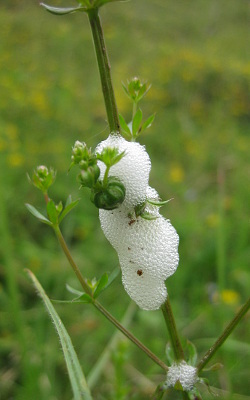Take part in the Spittlebug Survey 2020
Published: 24 May 2020
The current warm weather would normally have entomologists out and about looking for insects and attending events. However, the Covid-19 pandemic has meant that events have been cancelled and entomologists are restricted on what they can do. So, I'm sure you'll be delighted to hear that you can contribute to some fantastic entomological research whilst on your daily walk and even from your own garden by taking part in the Spittlebug Survey 2020.

Spittle, or 'cuckoo spit', is produced by the nymph of the spittlebug or froghopper
Spittlebug survey 2020
Did you know that the 'cuckoo-spit' that you see in spring is produced by the immature stage (nymph) of a spittlebug or froghopper? It is thought that the spittle is produced to protect the nymphs from drying out and from their predators. Once the nymphs emerge as adults, usually in late June, they leave their spittle 'nest' behind and become free flying. The name froghopper reflects the fact that their face is rather bulbous and therefore froglike, and that they are one of the most powerful jumpers in the animal kingdom. There are ten species of froghopper in Britain. The so-called Meadow Spittlebug, Philaenus spumarius, is one of our commonest insects and has possibly the broadest diet of any insect, being known to feed on more than 400 species of plant.
Interest in these insects has recently been heightened by the fact that they all feed on the liquid contents of the plant xylem tissue and are therefore capable of transmitting various plant diseases that reside there. One of these, the bacterium Xylella fastidiosa, has recently been responsible for the death of millions of olive trees in southern Italy. Fortunately, the Xylella bacterium has NOT been found in the UK, but there is a danger that it could be accidentally introduced in imported plants (especially lavender, rosemary and olive trees).
We need to collect good data on two aspects of these insects to understand better how the Xylella bacterium would spread if it were ever introduced into Britain: the geographical distribution of the different species of spittlebug and what plant species they feed on. Last year, we started to collect some of this information through a national survey, funded by the Biotechnology & Biological Sciences Research Council (BBSRC) and coordinated through the RHS, focused on gardeners recording spittle on their garden plants. This year, the restrictions on movement due to Covid-19 mean that we have to be careful about extending the survey into the wider countryside. Nevertheless, we hope that people will enjoy recording spittle in places that they visit as part of their daily exercise. Of course, those people lucky enough to have a garden will still be able to record the presence of cuckoo-spit on the plants in their garden.
Can you help? It would mean recording cuckoo-spit when you find it in your garden or elsewhere and especially the plant species on which you find it. Your plant identification skills will help us collect vital information. Please consider contributing to this important survey. Much more information and an online form for submitting your sightings can be found on our website at: www.spittlebugsurvey.co.uk. We have developed an 'exercise sheet' for families to follow when confined to their gardens, that should appeal particularly to young children: https://www.jic.ac.uk/app/uploads/2020/05/Spittlebug-activity-sheet-v2.pdf. We have also recently released a short video on how to find spittlebugs: https://www.youtube.com/watch?v=anfH8DAC7p8
Please be sure to follow the government's instructions at the time about social distancing when walking in the countryside.

The Meadow Spittlebug, Philaenus spumarius
Return to the main news page.
This information is available as an RSS newsfeed. Information on how you can use our newsfeeds is available.
![Amateur Entomologists' Society home page [Logo]](/images/aes-logo-wplant.gif)